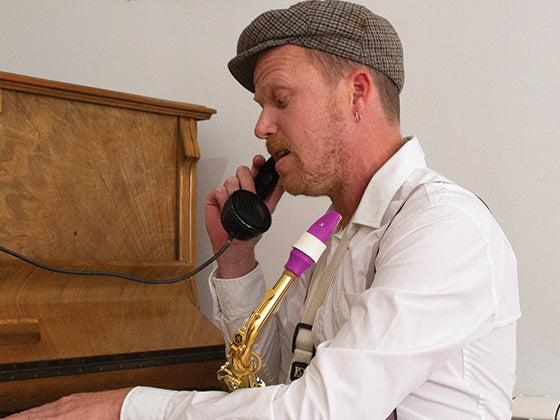This article is the first exercise of the series Practice Your Own Sound. Sylvie shows you three exercises for working on your saxophone sound. The best is to practice them in that order: first, long tones, then the overtones, and finally the work on 5ths and 8ves. So, let's go!
Long tones: Why?
Because it feels good, to relax, and to help you get into the zone!
The long tones are one of the most important exercises when practicing your saxophone skills. You will learn a good embouchure, a strong connection with your instrument and a better knowledge of your body.
They are also a form of sonic meditation, to dive into the sound and a way to become centered and focused for a good practice session.
Long tones: How?
So, for a good long tone session, you need:
-
a tuner
-
good comfortable flat shoes (or socks)
-
to push yourself, if that's not your norm
-
a quiet space without distractions (avoid TVs or kids in the background)
-
not to be afraid of playing just one note, for a long time, even (and especially) if it is ugly
Blow
You're surrounded by peace and quiet in your practice space, assemble your saxophone with love and care, and turn on your tuner. Stand up with your knees relaxed, your pelvis flexible, and your back straight but not rigid. Breathe deeply and blow a note from the medium register, between C# and A... blow the note you hear and feel best (it is important to listen and feel while playing long tones).
The attack is done without the tongue and should be clear and precise, straight. The sound goes "hhaaaaa" and not "pwwaaaa". Repeat the attack until it is clean.
So now you are blowing, the note is beautiful, the note is ugly, it doesn't matter, let go of your thoughts and focus on your body. Blow as long as you can, without being judgmental. Relax, loosen the jaw. Open the throat, relax the larynx, push up the diaphragm, tighten the butt, blow for as long as you can. Finish the note on a decrescendo.
Become the sound
Become the sound, become one with it, follow it and melt into it. Play the same note several times, trying to be in tune, with a stable frequency, and smile. Smiling is essential for being in tune and developing the right facial muscles.
Play the same note forte, piano, pianissimo. Pianissimo long tones are the best. They will kill you but they are such a good exercise! Smile, loosen the jaw, blow from the bottom, push the air.
You just spent 15 minutes on one note, congrats! Either stop here and practice your scales at 40bpm, or keep playing long tones, in the low register then in the high one.
Practice a lot of low Bb, B and C long tones.
Remember, always, to smile, especially in the higher register. The muscles around your mouth should ache a little if you practice correctly, a bit like sore muscles. You will build strength and endurance day after day. Do long tones everyday, for at least 10/15 minutes.
Hoping this will help you on your sonic journey, I wish you a happy dive into the Sound!
Don't miss the other exercises of the series:
And after working on your sound, you can practice your scales!













